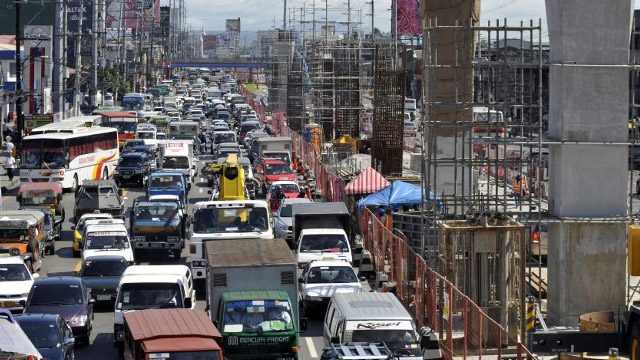SUMMARY
This is AI generated summarization, which may have errors. For context, always refer to the full article.

 MANILA, Philippines – A draft of the Philippines’ Intended Nationally Determined Contribution (INDC) for the global climate agreement to be forged in December was presented to stakeholders on Thursday, September 24.
MANILA, Philippines – A draft of the Philippines’ Intended Nationally Determined Contribution (INDC) for the global climate agreement to be forged in December was presented to stakeholders on Thursday, September 24.
The draft, obtained by Rappler, shows that the Philippines will unconditionally reduce greenhouse gas emissions (GHG) by “about 10% from energy and transport sectors by 2030 relative to Business-As-Usual [levels].”
Read the INDC draft here:
This means that instead of emitting 219 metric tons of carbon equivalent (MTCO2e) by 2030 – the amount of emissions the country is projected to emit – the Philippines will commit to emit only 196 MTCO2e.
If the Philippines receives funds, technology, and investments from the international community, it will reduce energy and transport GHG emissions by another 10%, reads the draft.
The unconditional and conditional mitigation contributions put together amount to 20% GHG emissions reductions by 2030.
It used as a reference point, the Business-As-Usual (BAU) scenario from 2010 to 2030.
The INDC draft was presented by Climate Change Commissioner and Secretary Lucille Sering a week after a House hearing wherein the Climate Change Commission (CCC) was criticized for lack of transparency in the INDC crafting process.
The crafting of the draft involved consultations with government agencies, companies of affected sectors, civil society groups, and scientists.
Options to reach targets
The CCC also presented a list of options the Philippine government can undertake in order to reach the target reductions.
The strategies in the energy sector include increased investments in renewable energy and natural gas, promotion of biodiesel blending in vehicle fuels, promotion of LED lighting, and improving home lighting to make it more efficient. One other option presented was nuclear energy.
To reduce emissions in the transport sector, the CCC said the Philippines could improve public transportation by investing in Bus Rapid Transit and trains, and by modernizing jeepneys.
By improving public transport and promoting the use of cleaner fuel, the government can significantly lessen vehicle emissions which contain GHGs.

The draft INDC also lists adaptation contributions. It says that the country’s priority adaptation measures include improving climate change forecasting and monitoring, use of vulnerability assessments as bases for its programs and plans, and the enhancement of climate and disaster-resiliency in agriculture, water and health.
The final version of the INDC will be submitted to President Benigno Aquino III for approval. Once greenlighted, it will be submitted to the United Nations by October 1, said Sering.
October 1 is the UN’s deadline for INDCs to be included in a compilation of INDCs that will serve as basis for the Paris Agreement on Climate Change to be finalized at the 21st Conference of Parties in Paris, France. (READ: What’s happening in Paris in December? 10 things to know)
This agreement will serve as the world’s action plan to combat and prepare for climate change.
The INDC draft reads that it is only an “initial” submission based on “current available data.” It will be updated “as more data becomes available and conditional to agreements by the Parties.”
Backed by robust data?
But some civil society groups and officials questioned the presented INDC draft.
Christian Monsod, chair of the Philippine Council for Agriculture and Fisheries Committee on Climate Change, even walked out of the meeting after saying that the INDC appeared to be the work of only a small group of people.
“This is not nationally-determined,” he had said.
The Department of Agriculture repeated its stance on the INDC, saying the Philippines is not even obligated to submit an INDC, and that mitigation targets could stunt the growth of sectors like agriculture.
But Tony La Viña, who served as spokesman for the Philippine delegation to climate negotiations, says the Philippines is duty-bound to submit an INDC.
“Otherwise, we lose moral and political high ground to participate effectively in the negotiations. We should not go to Paris if we have no INDC by then,” La Viña, dean of the Ateneo School of Government, told Rappler in a text message.
Sering’s fellow commissioner, Heherson Alvarez, had asked if the data behind the mitigation target of the INDC was robust enough.
The Philippine Movement for Climate Justice (PMCJ), a climate advocacy group, voiced the same concern.
They wondered if the projected BAU scenario – or the GHG emissions if the Philippines were to do nothing until 2030 – included the 11,000 megawatts to be generated by the 29 coal-fired plants the Department of Energy (DOE) has approved. (READ: Legarda questions PH use of coal for energy)
The DOE had replied that only 4,000-megawatts from committed coal-fired plants (those with financial backers) had been considered in the computation.
“But if they included all 11,000 megawatts, the Business As Usual levels would be higher and so the emission reduction target should be bigger,” said PMCJ national coordinator Gerry Arances.
He said that with the speed by which coal-fired plants are transitioning from approval to construction stage, the BAU levels until 2030 should reflect all approved plants, not just the ones with financial backing.
Groups like PMCJ and Greenpeace want the Philippine INDC to contain clear commitments to cut down on coal as a source of power.
La Viña also has “concerns about the comprehensiveness and extent of consultations.”
Nevertheless, he said he supports the current draft “with some additional clarifying text that assures further consultations, adherence to environmental standards, and respect and promotion for human rights.” – Rappler.com
Add a comment
How does this make you feel?
There are no comments yet. Add your comment to start the conversation.